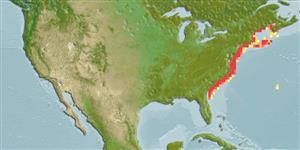分类 / Names
俗名 | 同种异名 | Catalog of Fishes(属, 种) | ITIS | CoL | WoRMS | Cloffa
Teleostei >
Clupeiformes (Herrings) >
Alosidae (Shads and Sardines)
Etymology: Brevoortia: From James Carson Brevoort (1818-1887), studie the fauna from Ohio and South Caroline (Ref. 45335).
Environment: milieu / climate zone / depth range / distribution range
生态学
海洋; 半咸淡水 ; pH range: 1.0 - 36.0; 海洋洄游的 (Ref. 51243); 深度上下限 0 - 50 m (Ref. 188). 亞熱帶的; ? - 26°C (Ref. 38970); 46°N - 30°N, 81°W - 64°W (Ref. 54290)
Western Atlantic: Nova Scotia, Canada southward to Indian River, Florida, USA.
西大西洋: 加拿大的新斯科舍省向南至美國佛羅里達的印地安河。
Length at first maturity / 大小 / 重量 / 年龄
Maturity: Lm 25.0, range 18 - 32 cm
Max length : 50.0 cm TL 雄鱼/尚未辨别雌雄; (Ref. 188)
背棘 (总数): 0; 背的软条 (总数): 18-24; 臀棘 0; 臀鳍软条: 18 - 24. Upper jaw with median notch. Pelvic fin with rounded hind margin, inner fin rays equal or nearly equal to outer fin rays when fin folded back. Pre-dorsal scales modified; scales on back, above base of anal fin and at base of tail much smaller and irregularly placed. A black spot behind gill opening, followed along flank by approximately 6 lines of smaller spots (Ref. 188). Silvery, with brassy sides and a dark bluish green back (Ref. 7251).
上颌有中央的凹槽。 腹鳍有圆的后缘, 内部的鳍条等于或者几乎等于外部的鳍条何时鳍褶背面。 前背部的鳞片修正; 鳞片背面,上方臀鳍基底鳍而在尾部的基底较小而且不规则地放置。 被跟随的一个黑色的斑点在后鳃裂沿着侧面大约较小的斑点的 6条线。 (参考文献 188) 银色的, 有黄铜色的侧边与一个深蓝色的绿色背面.(参考文献 7251)
Found inshore in summer, but at least some moving into deeper water in winter. Adults are found in near surface waters (Ref. 38984), usually in shallow areas overlying continental shelf, in greatest abundance immediately adjacent to major estuaries (Ref. 4639). Juveniles are also generally pelagic, with smallest size groups farthest up river (Ref. 38986). Form large and very compact schools, both of juveniles and adults. Migrate north - south; also in and out of bays and inlets. Feed by filtering phytoplankton (diatoms (Ref. 5951)) and zooplankton (small crustaceans, annelid worms and detritus (Ref. 5951)). High water temperatures apparently limit breeding. Spawn probably all year; nursery areas in estuaries. Larvae are pelagic (Ref. 38985), probably spend about a month in waters over continental shelf (Ref. 38983), entering estuarine waters at about 10 mm and larger (Ref. 844). Marketed fresh, salted, canned or smoked. Mainly used for production of oil, fertilizer and fishmeal (Ref. 188). Parasites found are isopods, copepod, cestodes and trematodes (Ref. 37032).
在夏天发现于岸边了, 但是至少一些迁进较深的水域冬天时。 成鱼在水表面 (参考文献 38984) 的附近被发现于, 通常在过度地大陆架的水浅的区域, 在最大的丰度中紧邻主要的河口.(参考文献 4639) 稚鱼也通常是大洋性, 鱼群最小溯河最远。 (参考文献 38986) 形成大的与非常紧密的鱼群, 稚鱼与成鱼都有。 回游南北; 也在湾内中来回进出。 藉着滤食浮游植物觅食与浮游动物。 高水温显然地限制繁殖。 整年可能产卵; 在河口的繁殖场。 仔鱼是大洋性的 (参考文献 38985), 大约一个月可能在大陆架 (参考文献 38983) 上的水域中度过, 于大约 10 mm 进入河口的水域与比较大的.(参考文献 844) 在市场上销售新鲜的,盐腌的, 将或者装于罐头烟熏了。 主要地用来了油,肥料与鱼粉的生产。 (参考文献 188) 发现的寄生虫是等足目动物,桡脚类的动物,条虫与吸虫。 (参考文献 37032)
Life cycle and mating behavior
成熟度 | 繁殖 | 产卵场 | 卵 | 孕卵数 | 仔鱼
Breeding season apparently limited by high water temperatures (20.5°C monthly mean maximum). Spawning activity occurring almost every month in some part of the range (Ref. 2472, 39013, 844). Spawning temperature ranges from 4.4°C to 23.6°C, with peak activity at 15-18°C (Ref. 39014). Salinity ranges from 10 ppt (Ref. 39015) to usually greater than 25 ppt (Ref. 844). Fecundity observed is from 38,000 to 631,000 eggs per season (Ref. 39013).西大西洋: 加拿大的新斯科舍省向南至美國佛羅里達的印地安河。
Whitehead, P.J.P., 1985. FAO Species Catalogue. Vol. 7. Clupeoid fishes of the world (suborder Clupeoidei). An annotated and illustrated catalogue of the herrings, sardines, pilchards, sprats, shads, anchovies and wolf-herrings. FAO Fish. Synop. 125(7/1):1-303. Rome: FAO. (Ref. 188)
人类利用
渔业: 高经济性
工具
特别资料
下载 XML
网络资源
Estimates based on models
Preferred temperature (Ref.
123201): 7.5 - 24.4, mean 13.2 °C (based on 120 cells).
Phylogenetic diversity index (Ref.
82804): PD
50 = 0.5156 [Uniqueness, from 0.5 = low to 2.0 = high].
Bayesian length-weight: a=0.01000 (0.00534 - 0.01873), b=3.10 (2.94 - 3.26), in cm total length, based on LWR estimates for this species & Genus-body shape (Ref.
93245).
营养阶层 (Ref.
69278): 3.2 ±0.2 se; based on diet studies.
Generation time: 2.8 (2.4 - 3.6) years. Estimated as median ln(3)/K based on 38
growth studies.
回复力 (Ref.
120179): 中等的, 族群倍增时间最少 1.4 - 4.4年 (K=0.4; tm=1-3; Fec=38,000).
Prior r = 0.31, 95% CL = 0.20 - 0.46, Based on 1 stock assessment.
Fishing Vulnerability (Ref.
59153): Low to moderate vulnerability (30 of 100).
Climate Vulnerability (Ref.
125649): Moderate vulnerability (45 of 100).
Nutrients (Ref.
124155): Calcium = 87.7 [51.9, 140.0] mg/100g; Iron = 1.45 [0.83, 2.30] mg/100g; Protein = 20 [19, 21] %; Omega3 = 0.58 [0.35, 0.93] g/100g; Selenium = 21.6 [11.4, 40.2] μg/100g; VitaminA = 8.6 [3.6, 21.0] μg/100g; Zinc = 0.964 [0.676, 1.343] mg/100g (wet weight);
